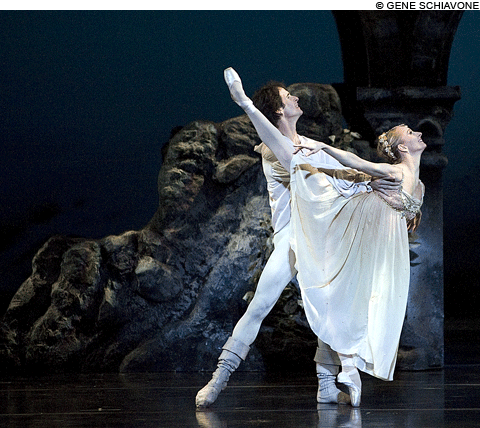
PRIMA ASSOLUTA Whether she was dancing Juliet (as here) or Lucille Ball, she was the best. |
The bad news — really bad news — this past week is that principal dancer Larissa Ponomarenko is retiring after 18 years with Boston Ballet. (She will, however, be staying on as a ballet master.) This is not a complete surprise: over the past few seasons, she's been given less and less to do. Yes, there've been injuries, and yes, she's old by normal prima ballerina standards. Then again, Margot Fonteyn was older — 42 — when she first danced with Rudolf Nureyev. And Ponomarenko has never been "normal." She arrived at the company from her native Ukraine, with husband Viktor Plotnikov, by way of Mississippi Ballet and Tulsa Ballet. Brought in as a principal, she made an unforgettable company debut as Aurora in Sleeping Beauty, slipping (on a stray rose petal?) as she entered and sitting right down. Then she got right up and started in on 18 years of extraordinary performances.
There was never anything generic about her — she could break your heart just standing in fourth position. And you'd expect a graduate of the Vaganova Ballet Academy in St. Petersburg to be exquisite in Sleeping Beauty and Swan Lake. But there was a lot you might not have expected. The world of her inner child was infinite; even in her 30s, she was the youngest, freest, most innocent of the company's Giselles and Juliets. She was a romantic, perching on Patrick Armand's knee in Daniel Pelzig's Nine Lives, conjuring Audrey Hepburn in his An American in Paris. She was side-splittingly funny; when in Pelzig's The Princess and the Pea she had to climb to the top of those nine mattresses, it seemed she must have spent her nights back home in Kharkov watching I Love Lucy reruns. One minute she was turning Balanchine's Mozartiana into a hymn to Terpsichore (you could practically see the stained-glass windows); the next her Kate was bashing Lucentio and Hortensio in John Cranko's The Taming of the Shrew, or her Hermia was going into high dudgeon after discovering Demetrius and her Lysander both pawing Helena in Bruce Wells's A Midsummer Night's Dream. She could save an indifferent production, like the Nureyev-inspired staging of Le Corsaire; she could make a great ballet like Cranko's Onegin even greater, the equal of Pushkin's novel.
Every time you thought there had to be something she couldn't excel at, she excelled at it. When the company had to get down, as in, say, Twyla Tharp's In the Upper Room, she got downest. Still, it was a surprise when she emerged as Jorma Elo's muse. Surely all that incessant windmilling and spinning and displacement of body parts couldn't be her forte? Guess again. Even in a short, "abstract" piece like Plan to B, the way she "swam" across the stage gave Elo's movement an extra dimension. She was the puppeteer of his Brake the Eyes, a five-year-old playing with her toys and speaking in Russian. In his Sacre du Printemps, she was a new kind of Chosen One, not a victim but a heroine. In this spring's Tchaikovsky, she gamboled with a dancer half her age, Jeffrey Cirio, and they seemed made for each other, whether portraying children or young lovers or a struggling couple. Even her nasal, wistful, Russian-accented voice was out of this world; every time I heard her sing, "Fly me to the moon, so I can play among the stars/Let me see what spring is like on Jupiter and Mars," I'd think, "Who needs Sinatra?" You couldn't imagine anyone else in these three roles; in the Boston productions, no one else danced them.